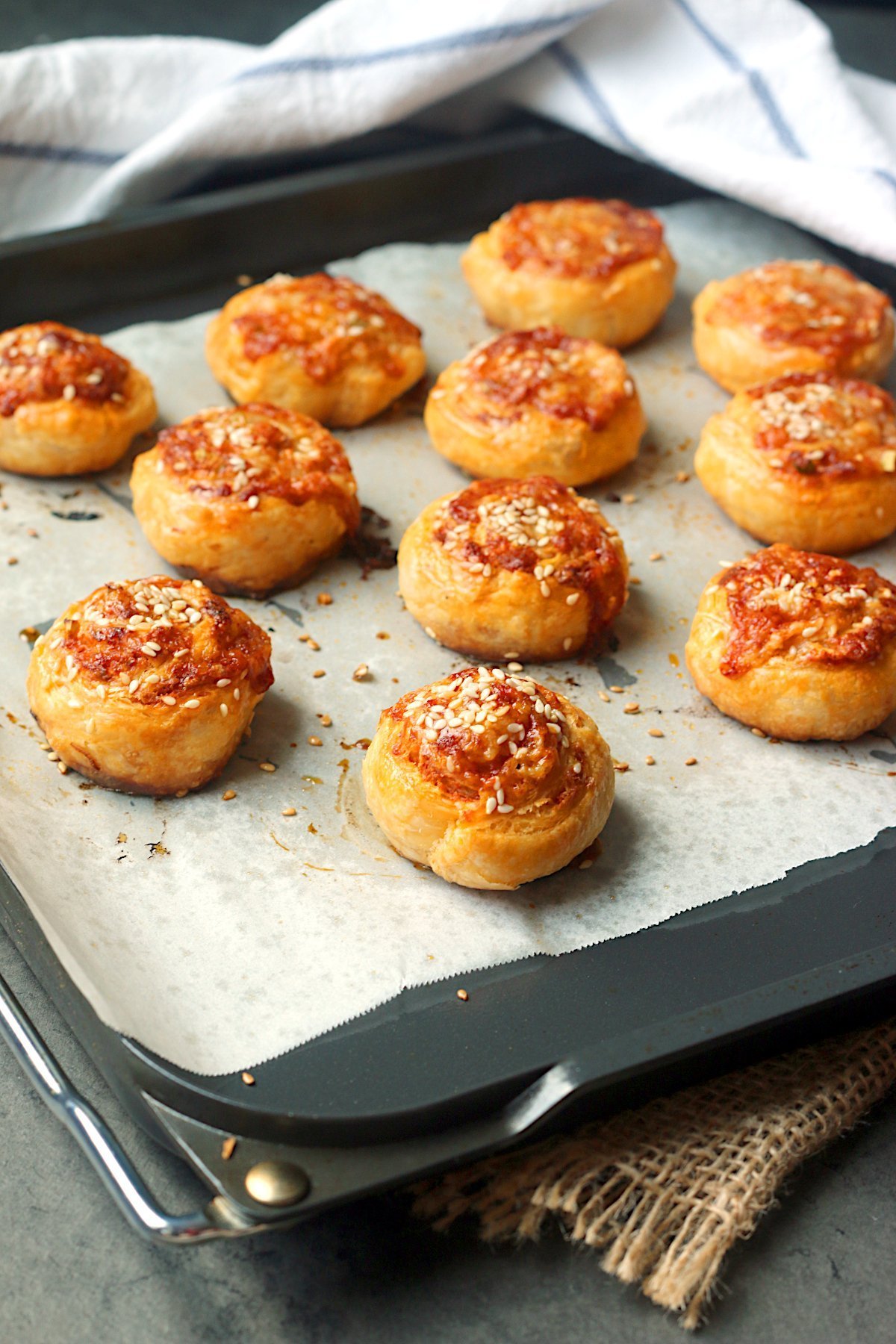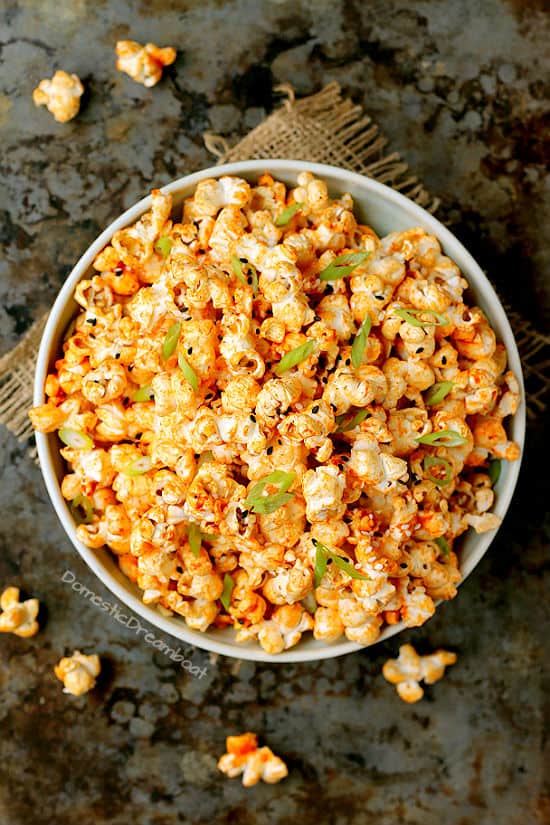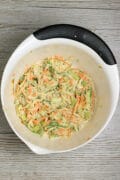Korean Vegetable Pancake (Yachaejeon)
Korean Vegetable Pancakes are pan-fried savory pancakes made from a variety of sliced or shredded vegetables.
Edmonton has a couple of foods that it’s well-known or famous for. Both of these foods are ubiquitous around Edmonton, available at many different types of restaurants. One is these foods is the donair, an import from Halifax, but which Edmonton does a little differently.
The other is the Green Onion Cake, which is a Northern Chinese dish that was first made popular by The Green Onion Cake Man, sold at various festivals and events in Edmonton. There are different types of Green Onion Cakes available in all sorts of restaurants around Edmonton, including the original, which are also available to cook at home.
My first experience with Green Onion Cakes wasn’t actually with Green Onion Cakes at all, but with Korean Vegetable Pancakes (Yachaejeon), though I didn’t know that at the time. I got them with my cousin at a local farmer’s market on her recommendation shortly after moving to Edmonton for University.
Though they were called “Green Onion Cakes” on the menu (the Korean version of these is called pajeon, and is very different from the Chinese version, but still delicious), they were actually Korean vegetable pancakes, made with many types of vegetables, not just green onions. I loved them and ordered them many, many times over the years.
I don’t know if that same vendor is still around, but I recently decided to make Korean Vegetable Pancakes for myself and found that it’s actually very easy. Since the recipe doesn’t have to be set in stone, and a variety of vegetables can be used to make them, it’s also a great way to clean out the produce drawers of your fridge.

What are Korean Vegetable Pancakes (Yachaejeon)?
Korean Vegetable Pancakes are pan-fried savory pancakes made from a mix of sliced or shredded vegetables held together with a wheat-based batter. The pancakes turn out slightly crispy on the edges, with soft interiors.
The vegetables used can vary, but often include green onions (there is also a variation called pajeon or Korean Green Onion Cakes that uses only green onions), but can also include zucchini, carrots, mushrooms, onions, sweet potatoes, etc. They’re usually served with a dipping sauce, in this case a spicy gochujang-based sauce, but often with a soy-based sauce as well.

How to Make Korean Vegetable Pancake
Korean Vegetable Pancakes are very easy to make (in my opinion, flipping them is the hardest part). I’ll often whip them up as a quick and easy dinner, or even lunch.
Start by making the gochujang dipping sauce, which simply involves stirring all of the ingredients (gochujang, soy sauce, rice vinegar, sugar, and sesame oil) together in a small bowl. Set this aside until you’re ready to serve.
Next, prep your vegetables. In general, you want your vegetables thinly sliced or shredded. Green onions should be cut into 1″ (2.5cm) lengths. The total amount of vegetables you should have for this recipe is 2 1/2 to 3 cups. If you have significantly more or less than this, you may need to adjust the amount of batter you use.
Add all of the vegetables to a bowl, then mix up the batter in a separate bowl. Whisk together the flour, cornstarch, salt, and baking powder, then whisk in the water. The batter will be thin. Pour it over the vegetables, then toss everything together.
Heat 1-2 Tablespoons of oil in a non-stick skillet (1 Tablespoon for a smaller 10″ skillet, 2 Tablespoons for a larger 12″ skillet). Note that while it’s possible to cook all of the batter into a large pancake in a 12″ skillet, I find it very difficult to flip this way. I prefer making 2-3 smaller pancakes in a 10″ skillet, and keeping them warm in the oven, if needed.
Cook the pancake, covered, until well browned on the bottom, then carefully flip. Cook on the second side, uncovered, until the bottom is browned. Cut into squares or wedges, and repeat with the remaining batter. Serve with the prepared gochujang dipping sauce. If you have leftovers, reheat in an air-fryer or toaster oven for the crispiest results.

Korean Vegetable Pancake Ingredients
Korean Vegetable Pancakes are flexible and can be made with many different vegetables. They’re a great way to clean out the produce drawers of your fridge. Below is a list of what I often use, plus some ideas for other vegetables that will work well. Aim for a total of 2 1/2 to 3 cups of prepped vegetables total.
- Green onions
- Carrots
- Zucchini
- Other vegetables such as thinly sliced onion, shredded sweet potato, thinly sliced mushrooms, thinly sliced bell or hot pepper can also be used. Avoid watery vegetables like tomato, cucumber, or lettuce.
- All-purpose flour – Use a gluten-free all-purpose flour blend to make your vegetable pancake gluten-free.
- Cornstarch
- Kosher salt
- Baking powder
- Cold water
- Canola oil or other neutral-flavored cooking oil
- Gochujang – Gochujang is a Korean condiment made from gochugaru (a red chile pepper) and other ingredients. It is spicy, savory, and sweet, and is used in many Korean dishes. You can find it in the International aisle of very well-stocked grocery stores or in Asian markets (I buy mine at T&T or H-Mart), usually in plastic tubs.
- Soy sauce
- Rice vinegar – Find rice vinegar in the vinegar aisle of any well-stocked grocery store.
- Granulated sugar or honey
- Sesame oil – You can find sesame oil in the International aisle or with the other oils in well-stocked grocery stores. It imparts a strong sesame flavor, so it’s usually used in small quantities.

Want more Korean-inspired recipes?
Korean Vegetable Pancake Nutrition Notes
The nutrition information in the recipe below is for 1/4 of the recipe. It includes the specific vegetables included in the recipe. If you substitute other vegetables, the nutrition information may vary slightly.
This recipe is dairy-free and vegan as written. To make your Korean Vegetable Pancake gluten-free, replace the all-purpose flour with a gluten-free all-purpose flour blend.
Equipment
Ingredients
Instructions
- Make the gochujang dipping sauce: Stir together 2 Tablespoons gochujang, 1 Tablespoon soy sauce, 1 Tablespoon rice vinegar, 1 Tablespoon granulated sugar, and 2 teaspoons sesame oil in a small bowl or measuring cup. Set aside.
- Prep the vegetables: cut 4-5 medium (1 cup) green onions into 1" lengths, peel and shred 2 medium (1 cup) carrots, trim the ends, and grate 1 small (1 cup) zucchini. Measure the prepped vegetables. You should have 2 1/2 to 3 cups total. If you have significantly more or less than this, you may have to adjust how much batter you use. If you decided to use other vegetables (eg. onion, sweet potato, mushrooms and/or peppers, make sure they replace other vegetables, and stay within 3 cups of vegetables). Add the prepped vegetables to a large bowl.
- Mix up the batter: In a medium bowl, whisk together 1/2 cup all-purpose flour, 1/4 cup cornstarch, 1/2 teaspoon kosher salt, and 1/2 teaspoon baking powder. Whisk in 3/4 cup cold water. The batter will be thin.
- Pour the batter over the prepped vegetables and toss to coat.

- Heat 1 Tablespoon of canola oil in a medium to large non-stick skillet over medium-high heat. Note that if you have a large skillet (12" or larger), it is possible to cook all of the batter into one pancake, but it will be much harder to flip (in this case, use 2 Tablespoons of oil).
- Add one-third to half of the batter to the hot skillet, spreading it into a circle. Cover the pan with a lid, and cook until the bottom of the pancake is browned and the top is beginning to set. Carefully flip the pancake, and continue to cook, uncovered, until browned on the other side.
- Remove the pancake from the skillet and transfer to a cutting board. Cut into squares or triangles and serve with the gochujang dipping sauce. Repeat with the remaining batter, adding 1 Tablespoon of oil to the skillet before adding batter.
Nutrition
Tried this recipe?
Please Consider Leaving a Review!





